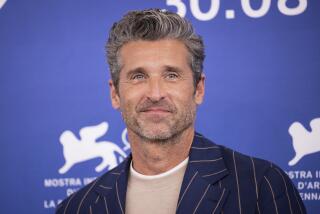Resurrected Caddie
- Share via
LEMONT, Ill. — Garland Dempsey doesn’t remember meeting Mike Smollen or Christian Ganz. Ditto for Dan Capuano and Dave Spivak.
But when the caddie saw the four again last Wednesday, he greeted them as if they were the most important people in his life.
In a way, they are.
“It’s really hard to begin to tell you how happy I am to be here,” said Dempsey, who was revived by the four Lemont paramedic-firefighters on July 3, 1999, after he collapsed and his heart stopped on the 15th hole at the Western Open.
“I could have been a statistic. Thanks to the Lemont Fire Department and the EMTs out there, they kept me from being a permanent statistic,” Dempsey said. “I’m really, really happy to be here with everybody today.”
Dempsey, the longtime caddie for PGA Tour player John Maginnes, went into cardiac arrest last year after walking off the 15th tee on a hot, humid afternoon. In the middle of the golf course and surrounded by thousands of people, it would have been tough for an emergency vehicle with a regular defibrillator to get to Dempsey right away.
But Smollen and Ganz were in a vehicle that carried an automated external defibrillator (AED), a small, portable machine that can be used to shock someone’s heart.
“He was as good as gone,” Ganz said. “If he wasn’t defibrillated, he would be dead today.”
Instead, Dempsey shows few signs of last year’s ordeal. He’s about 15 pounds lighter after cutting out the fried and spicy foods he loved, and he has scars on his right leg and chest from the surgery. But he was back at work 10 weeks after having quadruple bypass surgery and has resumed his normal life.
He came back to Cog Hill Golf and Country Club to thanks the paramedics and tout “Links for Life,” a partnership between the American Heart Association and Golf Digest that encourages golf courses to have AEDs.
Only a foot high and weighing about seven pounds, AEDs can be installed almost anywhere and can save valuable time for someone in cardiac arrest. Using two patches that are placed on the chest, the machine analyzes a person’s heart rhythm and determines whether the heart needs to be shocked.
If it does, an automated voice gives a command to press a button that will deliver a shock and restart the heart.
“I’m impressed with how easy it is to work,” said Dempsey, who watched a demonstration with a look of awe on his face. “I’m just very happy they had one out there.”
Ninety-five percent of Americans who suffer cardiac arrest die because they don’t receive immediate treatment, said Dr. David Cooke, president of the AHA’s Midwest Affiliate.
AEDs cost about $3,500, about one-third the price of a regular defibrillator. Because of their small size, they’re ideal for places where emergency vehicles might have difficulty reaching, Cooke said.
“The goal is to improve sudden cardiac arrest and heart attack survival rates,” Cooke said. “Garland’s life was saved by experts. But every person sitting here could do the same thing with a few hours of training.”
With their acres and acres of remote land, golf course are perfect spots for the machines, Cooke said. Since “Links for Life” began last October, more than 600 AEDs have been sold to golf courses throughout the country.
Cog Hill installed two last month.
Dempsey, who will work for ABC as a spotter this weekend instead of carrying Maginnes’ bag, hasn’t been back to the 15th hole yet. He joked that he wanted the paramedics to give him a ride out there so he could check out the tire tracks they left last year.
They laughed, but didn’t take him up on the offer.
“It’s great to have him come back and see him,” Smollen said. “In my 20 years, that’s probably the first time I’ve gotten to talk to and shake hands with somebody I’ve saved.”
More to Read
Go beyond the scoreboard
Get the latest on L.A.'s teams in the daily Sports Report newsletter.
You may occasionally receive promotional content from the Los Angeles Times.










